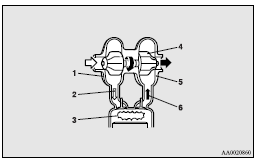Turbocharger operation
![]() Caution
Caution
► Do not run the engine at high speeds (for example, by revving it or by accelerating
rapidly) immediately after starting it.
► Do not stop the engine immediately after high-speed or uphill driving. First allow
the engine to idle to give the turbocharger a chance to cool down.
Turbocharger
The turbocharger increases engine power by pushing large amounts of air into the engine’s cylinders.
The finned parts inside the turbocharger turn at extremely high speeds and are subjected to extremely high temperatures. They are lubricated and cooled by engine oil. If the engine oil is not replaced at the specified intervals, the bearings may seize or emit abnormal noise.

1- Air compressor
2- Compressed air
3- Cylinder
4- Turbo fin
5- Turbine
6- Exhaust gas
See also:
Changing gears
Always use care to change the gear with the vehicle speed matched to the engine
speed. Proper shifting will improve fuel economy and prolong engine life.
Avoid shifting down at high speed, as this ...
Wiper blade rubber replacement
If the blades are frozen to the windscreen or rear window, do not operate the
wipers until the ice has melted and the blades are freed, otherwise the wiper motor
may be damaged.
Windscreen wiper ...
Manual reset mode
► When the average speed is being displayed, if you hold down the multi-information
meter switch, the average speed displayed at that time is reset.
► When the ignition switch is switch ...
